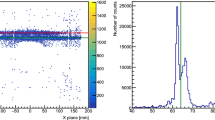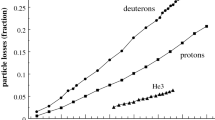Abstract
The deuteron breakup on heavy targets has been investigated in the framework of an improved quantum molecular dynamics model, focusing on the production of neutrons near zero degrees. The experimental differential cross sections of neutron production in the 102 MeV d+C reactions were reproduced by simulations. Based on the consistency between the model prediction and experiment, the feasibility of producing a neutron beam through the breakup of deuteron on a carbon target was demonstrated. Because of the nucleon Fermi motion inside the deuteron, the energy spectrum of the inclusive neutron near \(0^\circ\) in the laboratory exhibits considerable energy broadening in the main peak, whereas the long tail on the low-energy side is suppressed. By coincidentally measuring the accompanying deuteron breakup proton, the energy of the neutron can be tagged with an intrinsic uncertainty of approximately 5% (1\(\sigma\)). The tagging efficiency of the accompanying proton on the forward-emitted neutron can reach 90%, which ensures that the differential cross section in the (d,np) channel remains two orders higher than that in (p,n) after considering the measurement of accompanying protons. This enables the application of a well-defined energy neutron beam in an event-by-event scheme.






Similar content being viewed by others
References
T.J.O. Gorman, J.M. Ross, A.H. Taber et al., Field testing for cosmic ray soft errors in semiconductor memories. IBM J. Res. Dev. 40, 41–50 (1996). https://doi.org/10.1147/rd.401.0041
R.C. Baumann, Soft errors in advanced semiconductor devices-part I: the three radiation sources. IEEE Trans. Device Mater. Reliab. 1, 17–22 (2001). https://doi.org/10.1109/7298.946456
P. Pomp, Tutorial on neutron physics in dosimetry. Radiat. Meas. 45, 1090 (2010). https://doi.org/10.1016/j.radmeas.2010.06.021
T. Baumann, J. Boike, J. Brown et al., Construction of a modular large-area neutron detector for the NSCL. Nucl. Instrum. Meth. A 543, 517–527 (2005). https://doi.org/10.1016/j.nima.2004.12.020
J. Klug, J. Blomgren, A. Ataç et al., SCANDAL-a facility for elastic neutron scattering studies in the 50–130 MeV range. Nucl. Instrum. Meth. A 489, 282–303 (2002). https://doi.org/10.1016/S0168-9002(02)00576-4
R. Nolte, M.S. Allie, P.J. Binns et al., High-energy neutron reference fields for the calibration of detectors used in neutron spectrometry. Nucl. Instrum. Meth. A 476, 369–373 (2002). https://doi.org/10.1016/S0168-9002(01)01472-3
M. Österlund, J. Blomgren, S. Pomp et al., The Uppsala neutron beam facility for electronics testing. Nucl. Instrum. Meth. B 241, 419–422 (2005). https://doi.org/10.1016/j.nimb.2005.07.052
C. Andreani, A. Pietropaolo, A. Salsano et al., Facility for fast neutron irradiation tests of electronics at the ISIS spallation neutron source. Appl. Phys. Lett. 92, 114101 (2008). https://doi.org/10.1063/1.2897309
L. Ren, Y. Han, J. Zhang et al., Neutronics analysis of a stacked structure for a subcritical system with LEU solution driven by a D-T neutron source for 99Mo production. Nucl. Sci. Tech. 32, 123 (2021). https://doi.org/10.1007/s41365-021-00968-x
I.S. Anderson, C. Andreani, J.M. Carpenter et al., Research opportunities with compact accelerator-driven neutron sources. Phys. Rep. 654, 1 (2016). https://doi.org/10.1016/j.physrep.2016.07.007
H. Harano, T. Matsumoto, Y. Tanimura et al., Monoenergetic and quasi-monoenergetic neutron reference fields in Japan. Radiat. Meas. 45, 1076–1082 (2010). https://doi.org/10.1016/j.radmeas.2010.07.006
Y. Iwamoto, M. Hagiwara, D. Satoh et al., Characterization of high-energy quasi-monoenergetic neutron energy spectra and ambient dose equivalents of 80–389 MeV \(^7\)Li(p, n) reactions using a time-of-flight method. Nucl. Instrum. Meth. A 804, 50–58 (2015). https://doi.org/10.1016/j.nima.2015.09.045
H.C. Urey, E.G. Brickwedde, G.M. Murphy, A hydrogen isotope of mass 2. Phys. Rev. 39, 164 (1932). https://doi.org/10.1103/PhysRev.39.164
G.N. Lewis, N.S. Livingstone, E.O. Lawrence, The emission of alpha-particles from various targets bombarded by deutons of high speed. Phys. Rev. 44, 55 (1933). https://doi.org/10.1103/PhysRev.44.55
J. Chadwick, M. Goldhaber, A nuclear photo-effect: disintegration of the diplon by -Rays. Nature 134, 237–238 (1934). https://doi.org/10.1038/134237a0
G.M. Murphy, H. Johnston, The nuclear spin of deuterium. Phys. Rev. 46, 95 (1934). https://doi.org/10.1103/PhysRev.46.95
J.M.B. Kellogg, I.I. Rabi, N.F. Ramsey et al., An electrical quadrupole moment of the deuteron. Phys. Rev. 55, 318 (1939). https://doi.org/10.1103/PhysRev.55.318
N.K. Glendenning, G. Kramer, Nucleon-nucleon triplet-even potentials. Phys. Rev. 126, 2159 (1962). https://doi.org/10.1103/PhysRev.126.2159
M. Garcon, J.W. Van Orden, The deuteron: structure and form factors, in Advances in Nuclear Physics. ed. by J.W. Negele et al. (Springer, New York, 2001)
G. Berg, J. Blomgren, J. Cameron et al., Measurements of the proton-neutron correlation in deuteron breakup at 260 MeV. IUCF Sci. and Tech. Rep. p. 70-75 (1992). https://hdl.handle.net/2022/610
M. Jin, S. Xu, G. Yang et al., Yield of long-lived fission product transmutation using proton-, deuteron-, and alpha particle-induced spallation. Nucl. Sci. Tech. 32, 96 (2021). https://doi.org/10.1007/s41365-021-00933-8
W. Qiu, W. Sun, J. Su, Neutronic analysis of deuteron-driven spallation target. Nucl. Sci. Tech. 32, 94 (2021). https://doi.org/10.1007/s41365-021-00932-9
J. Aichelin, C. Hartnack, A. Bohnet et al., QMD versus BUU/VUU: same results from different theories. Phys. Lett. B 224(1–2), 34 (1989). https://doi.org/10.1016/0370-2693(89)91045-9
J. Aichelin,“Quantum” molecular dynamics-a dynamical microscopic n-body approach to investigate fragment formation and the nuclear equation of state in heavy ion collisions. Phys. Rep. 202, 233-360 (1991). https://doi.org/10.1016/0370-1573(91)90094-3
L. Ou, Z. Xiao, H. Yi et al., Dynamic Isovector Reorientation of Deuteron as a Probe to Nuclear Symmetry Energy. Phys. Rev. Lett. 115, 212501 (2015). https://doi.org/10.1103/PhysRevLett.115.212501
H. Liu, N. Ma, R. Wang, Nuclear Fermi momenta of 2H, 27Al and 56Fe from an analysis of CLAS data. Nucl. Phys. A 1018, 122377 (2022). https://doi.org/10.1016/j.nuclphysa.2021.122377
Y. Zhang, Z. Li, Probing the density dependence of the symmetry potential with peripheral heavy-ion collisions. Phys. Rev. C 71, 024604 (2005). https://doi.org/10.1103/PhysRevC.71.024604
Y. Zhang, Z. Li, Elliptic flow and system size dependence of transition energies at intermediate energies. Phys. Rev. C 74, 014602 (2006). https://doi.org/10.1103/PhysRevC.74.014602
L. Ou, Z. Li, X. Wu et al., A study of proton-induced spallation reactions by the improved quantum molecular dynamics model plus statistical decay models. J. Phys. G Nucl. Part. Phys. 36, 125104 (2009). https://doi.org/10.1088/0954-3899/36/12/125104
L. Ou, Z. Li, X. Wu, Dynamical isospin effects in nucleon-induced reactions. Phys. Rev. C 78, 044609 (2008). https://doi.org/10.1103/PhysRevC.78.044609
L. Ou, Z. Xiao, Orientation dichroism effect of proton scattering on deformed nuclei. Chin. Phys. C 44, 114103 (2020). https://doi.org/10.1088/1674-1137/abadf1
Y. Zhang, N. Wang, Q.F. Li et al., Progress of quantum molecular dynamics model and its applications in heavy ion collisions. Front. Phys. 15(5), 54301 (2020). https://doi.org/10.1007/s11467-020-0961-9
L.W. Chen, C.M. Ko, B.A. Li et al., Density slope of the nuclear symmetry energy from the neutron skin thickness of heavy nuclei. Phys. Rev. C 82, 024321 (2010). https://doi.org/10.1103/PhysRevC.82.024321
M. Dutra, O. Lourenço, J.S. Sá Martins et al., Skyrme interaction and nuclear matter constraints. Phys. Rev. C 85, 035201 (2012). https://doi.org/10.1103/PhysRevC.85.035201
Y. Zhang, Z.X. Li, C.S. Zhou et al., Effect of isospin-dependent cluster recognition on observables in heavy-ion collisions. Phys. Rev. C 85, 051602(R) (2012). https://doi.org/10.1103/PhysRevC.85.051602
Z. Lin, L. Zheng, Further developments of a multi-phase transport model for relativistic nuclear collisions. Nucl. Sci. Tech. 32, 113 (2021). https://doi.org/10.1007/s41365-021-00944-5
R.J. Charity, M.A. McMahan, G.J. Wozniak et al., Systematics of complex fragment emission in niobium-induced reactions. Nucl. Phys. A 483, 371–405 (1988). https://doi.org/10.1016/0375-9474(88)90542-8
R.J. Charity, L.G. Sobotka, J. Cibor et al., Emission of unstable clusters from hot Yb compound nuclei. Phys. Rev. C 63, 024611 (2001). https://doi.org/10.1103/PhysRevC.63.024611
S. Araki, Y. Watanabe, M. Kitajima et al., Systematic measurement of double-differential neutron production cross sections for deuteron-induced reactions at an incident energy of 102 MeV. Nucl. Instrum. Meth. A 842, 62–70 (2017). https://doi.org/10.1016/j.nima.2016.10.043
Y. He, C. Guo, J. Su et al., Study on deuteron formation mechanism in nucleon-induced reactions. Nucl. Sci. Tech. 31, 84 (2020). https://doi.org/10.1007/s41365-020-00788-5
W. Sun, W.W. Qiu, J. Su, Production of high-energy neutrons by interaction of a deuteron beam with matter. Appl. Radia. Isotopes 174, 109752 (2021). https://doi.org/10.1016/j.apradiso.2021.109752
S.Y. Xu, G.M. Yang, M.T. Jin et al., Probing the deuteron breakup and linking the cross sections of residue production between the neutron- and deuteron-induced spallation at 500 MeV/nucleon. Phys. Rev. C 101, 024609 (2020). https://doi.org/10.1103/PhysRevC.101.024609
T. Wakasa, S. Goto, M. Matsuno et al., Neutron production cross sections for (d,n) reactions at 55 MeV. Prog. Theor. Exp. Phys. 2017, 083D01 (2017). https://doi.org/10.1093/ptep/ptx099
H. Okamura, S. Ishida, N. Sakamoto et al., Mechanism of the forward-angle (d, pn) reaction at intermediate energies. Phys. Rev. C 58, 2180 (1998). https://doi.org/10.1103/PhysRevC.58.2180
S.D. Schery, L.E. Young, R.R. Doering et al., Activation and angular distribution measurements of 7Li(p, n)7Be(0.0+0.49 MeV) for \(E_p\)=25-45 MeV—a technique for absolute neutron yield determination. Nucl. Instrum. Meth. 147, 399–404 (1977). https://doi.org/10.1016/0029-554X(77)90275-0
M. Baba, Y. Nauchi, T. Iwasaki et al., Characterization of a 40–90 MeV 7Li(p, n) neutron source at TIARA using a proton recoil telescope and a TOF method. Nucl. Instrum. Meth. A 428, 454 (1999). https://doi.org/10.1016/S0168-9002(99)00161-8
T.N. Taddeuchi, C.A. Goulding, T.A. Carey et al., The (p, n) reaction as a probe of beta decay strength. Nucl. Phys. A 469, 125–172 (1987). https://doi.org/10.1016/0375-9474(87)90089-3
Author information
Authors and Affiliations
Contributions
All authors contributed to the study conception and design. Material preparation, data collection and analysis were performed by Ren-Sheng Wang, Li Ou and Zhi-Gang Xiao. The first draft of the manuscript was written by Zhi-Gang Xiao and all authors commented on previous versions of the manuscript. All authors read and approved the final manuscript.
Corresponding author
Rights and permissions
About this article
Cite this article
Wang, RS., Ou, L. & Xiao, ZG. Production of high-energy neutron beam from deuteron breakup. NUCL SCI TECH 33, 92 (2022). https://doi.org/10.1007/s41365-022-01075-1
Received:
Revised:
Accepted:
Published:
DOI: https://doi.org/10.1007/s41365-022-01075-1




